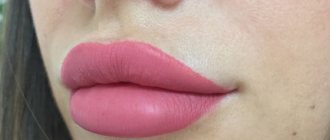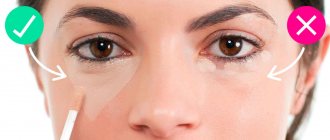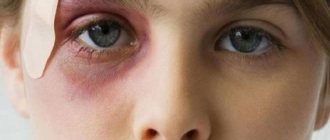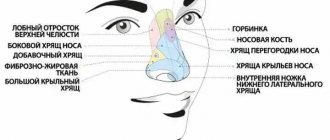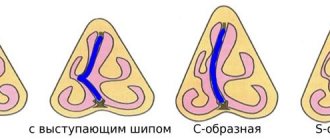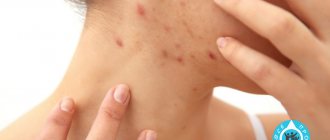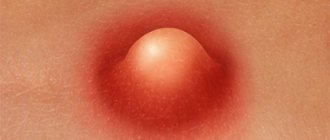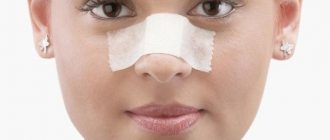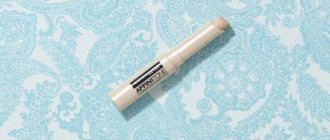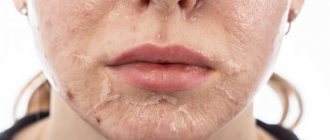Why does a bruise appear?
In medicine, any bruise is considered a hematoma. It occurs against the background of rupture of blood capillaries and is formed for one of the reasons:
- The presence of diseases of internal organs, problems with the circulatory system (leukemia, hepatic cirrhosis, von Willebrand disease, varicose veins, vasculitis).
- Mechanical impact on the body (bruise, blow, compression, injections).
Bruises under the eyes, which are popularly called bags, occur due to overwork of the body. It can be caused by insomnia, stress, severe physical and mental stress, and excessive drinking.
When is medical attention required?
If there is a bruise on the face without swelling and no pain, you do not need to seek help from a doctor. Treatment at home is sufficient. However, in a situation where the hematoma quickly increases in size, the victim’s well-being worsens - the attention of a doctor is required. If clinical manifestations occur, you must contact a medical facility:
- If the victim loses consciousness or suffers from painful sensations, the attention of a doctor is required. These signs indicate that the bruise on the cheek is accompanied by brain damage.
- Severe pain and pulsation of a hematoma on the cheek should not go unnoticed by a medical specialist.
- The weakness of the victim and an increase in the temperature center are reasons for a visit to the doctor.
- If a hematoma appears without a blow, this indicates vascular weakness and a lack of vitamins and minerals. To determine the exact cause, a doctor's consultation is required.
The mechanism of bruise formation
The causes of hematomas are related to the anatomy of the skin. It consists of three layers:
- Epidermis. This is a thin area that does not have blood vessels and performs a protective function. With a closed injury, it is not damaged.
- Dermis. Consists of connective tissue fibers. The capillaries located in the dermis play a special role in the appearance of bruises. Pain at the site of the injury is felt due to the presence of nerve endings in this layer.
- Hypodermis. Subcutaneous fat is located deeper than the other layers. It contains small vessels. This is where bruises form, since adipose tissue is much softer than connective tissue.
The severity of damage cannot be assessed by the area of the hematoma. A huge bruise may not affect the lower layers of the skin and may not damage the muscles.
Other features of the body play a special role in the formation of hematomas:
- blood composition;
- permeability of vascular walls;
- thickness of adipose tissue;
- structure of blood vessels.
The older a person is, the more often he or she develops hematomas. A child may have no trace left after a blow, while an old person will have a huge bruise due to a similar injury. This is due to the weakening of blood vessels, loss of elasticity of the walls and impaired circulation in them.
Bruises after injections
Reasons for appearance:
- Error in the process of choosing the injection site. For example, you need to give an injection on the upper part of your right buttock. Experienced doctors advise mentally dividing the buttock into four areas and injecting where necessary at the moment. If the person using the syringe made a mistake and hit another muscle part, sending the medicine to less elastic tissues, then there is a high probability that a bruise will appear in this place.
- The injection was not deep enough to have full impact. All gluteal muscles are located under an impressive layer of subcutaneous fat. If the syringe is not inserted to the full length of the needle, then the medicine is 100% likely to get into the fatty area, causing the formation of bruises.
- Got a viral infection. If foreign bacteria enter the body along with the injection, they will provoke the onset of a subcutaneous inflammatory process. In turn, it forms spots on the body that resemble multi-colored hematomas.
- They injected a very tense muscle. Under this influence, an abundant blood supply begins at the injection site, which can enter the fatty tissue. And blood that gets into the wrong place provokes the appearance of bruises.
Color change
The size and color of the bruise depend on several factors:
- location relative to the vessels (pulsating hematoma occurs as a result of disruption of a large artery, non-pulsating hematoma occurs due to damage to small capillaries);
- the amount of accumulated blood;
- duration of injury;
- force of mechanical action (the higher it is, the deeper the hemorrhage occurred in the tissue).
The appearance and resorption of a hematoma occurs in several stages, which are accompanied by a change in the shade of the bruise:
- Red-purple. The red color is a consequence of damage in the first hours after the injury. This shade is due to the penetration of red blood cells into the skin tissue, which contain oxyhemoglobin of the corresponding color. During these hours, a person feels the greatest pain, and edema forms in the form of swelling.
- Blue or purple. The next day, the bruise acquires this color because the process of oxidation of oxyhemoglobin in the tissues occurs. Resorption has not yet begun, but the swelling is gradually subsiding.
- Green. The hematoma acquires this shade 5-6 days after injury. This occurs due to the biochemical transformation of hemoglobin, which enters the tissue from red blood cells. Biliverdin is formed, which has a greenish tint. Pain and swelling will disappear by this time.
- Yellow. In the final stage, the bruise turns yellow because biliverdin is converted to bilirubin. Over time, the hematoma will disappear under the influence of macrophages, which absorb dead cells. The yellow spot dissolves and leaves no trace.
Similar phases are observed when a significant volume of blood is released. If ice was applied immediately after the blow, the bruise will not look as noticeable.
Elimination methods
The bruise on the face goes away on its own within a week. But this is a very long time, given the special localization and negative aesthetic role of such a phenomenon. And many owners of an unpleasant symptom want to know how to quickly remove cream from their nose.
First aid
Much depends on how you behave in the first minutes after a nose injury. Therefore, everyone should be familiar with first aid measures. Immediately after an injury, you should do the following:
- Feel the back of the nose for a fracture.
- Make sure there is no bleeding.
- Apply cold.
The latter is the most basic aspect to prevent bruising. Under the influence of cold, small vessels contract, and blood stops pouring under the skin. Ice from the freezer, a bottle or glass of cold liquid (water, juice, milk), metal objects (spoon, coin) and other improvised means can act as a source of low temperature. But you can’t keep it cold for a long time either: take a break every 5 minutes.
It is strictly forbidden to do actions that have the exact opposite effect: increasing blood circulation and dilating capillaries. Those who want to get rid of bruises should not rub their nose, press or massage it, or drink hot drinks (tea, coffee) or alcohol. Because of this, there will only be an increased release of blood into the tissue, which will certainly ensure the formation of cream on the nose.
The other aspects of first aid described above are also important. If your nose is bleeding, cold will also help stop it. But in this case, it is necessary to additionally insert cotton wool moistened with hydrogen peroxide into the nostrils and tilt the head slightly. By feeling the nose, you can identify its deformation - a consequence of a fracture. But then you cannot do without the intervention of an ENT doctor.
You should not think long about how to remove a bruise from your nose - immediately after the injury you need to provide yourself with first aid.
Further treatment
If the moment was missed and more than 2 hours have passed since the damage, then the cold will not help. The blood has already penetrated the tissue, which means that now it is necessary to pay attention to other methods to help fight bruises. First of all, you should protect your nose from repeated traumatization: do not press on it, wash and dress carefully, sleep on your back.
In order for the bruise to resolve quickly and not show off on the nose, you should use ointments, gels, creams and balms with absorbable components. These include the following:
- Troxerutin (Indovazin, Troxevasin).
- Heparin (Lioton, Trombless, Lavenum).
- Leech extract (Bruise-off).
- Badyaga (Express bruise, Badyaga 911).
- Comfrey (larkspur).
As you can see, the list of drugs for hematomas includes both traditional medicines and folk remedies. Their use must be agreed with the attending physician and carried out in accordance with the instructions. Non-steroidal anti-inflammatory drugs, also available in local form (Voltaren, Nurofen, Nise), can eliminate concomitant tissue disorders.
And from the next day, when the inflammatory phenomena subside, you can begin restorative procedures. Warming procedures allow you to remove plums from your nose faster. They will promote the resorption of an already formed hematoma. But they cannot be used immediately after an injury - the effect will be the opposite. The same applies to warming ointments (Finalgon, Nicoflex, Apizartron). Among the means of alternative therapy, you can use the following:
- Compresses from decoctions of calendula, chamomile, St. John's wort, coltsfoot, eucalyptus.
- Applications of grated potatoes, honey, burdock leaves, cabbage or plantain.
If the bruise does not disappear as quickly as we would like, but you still need to leave the house, then there is only one remedy left - to disguise it with the help of decorative cosmetics. Powder or foundation will do a good job of eliminating visual defects on the face, including the ill-fated cream.
You can quickly get rid of a bruise on the nose with the help of medications based on chemical or natural ingredients.
Cream on the nose has never made anyone happy. That's why everyone wants to get rid of it as quickly as possible. Which product removes bruises best is an individual question. There are many methods used in such a situation. But it is better to carry out correction as soon as the damage has occurred, avoiding the accumulation of blood in the tissues. If time has been lost, then you should not despair - other methods of eliminating bruises will help.
11.09.2017
Hematoma of the nasal septum is a subcutaneous hemorrhage formed due to compression, damage to capillaries and small vessels. In the nasal septum, a blood clot forms between the mucous membrane and the cartilage. Hematoma can be one- or two-sided.
Home treatments
If the bruise is caused by a blow, you should apply something cold to the sore spot and hold it there throughout the day. This will help reduce the size of the hematoma and speed up its healing. After 2 days, warm compresses are applied. If, apart from the external manifestation of bruising and swelling, there are no other alarming signs, you can do without going to the doctor.
Today, the pharmaceutical market offers a huge number of products to get rid of bruises. These include:
- Lyoton;
- Troxevasin;
- Bruise-off;
- Heparin ointment;
- Badyaga;
- Voltaren;
- Finalgon;
- Hepatrombin.
These ointments have wound healing, regenerating and analgesic effects. It is advisable to use them 7-8 hours after the impact. If you apply them immediately, they will increase swelling and provoke the appearance of a more pronounced hematoma.
As non-traditional methods of treatment, lotions with aloe, compresses with tincture of calendula and golden mustache, cabbage or potatoes, and garlic infusion are suitable. Before using traditional recipes and medications, you should make sure there are no contraindications.
Methods to quickly get rid of bruises
Fast-acting remedies for yellowish spots include medical ointments: “Gepatrombin gel”, “Fastum gel”, “Troxevasin”, “Indovazin” and so on.
If hematomas appear without the influence of a bruise, you can use more useful methods. You should include more egg yolks, fish oil and green foods like broccoli or spinach in your daily diet. They contain a lot of potassium, without which normal blood clotting is impossible. For additional effect, you can make regular compresses at the site of the hematoma, consisting of boiled potatoes in their jackets, honey and soda. This mixture is mixed until the consistency of a homogeneous paste and periodically lubricated bruises.
Onion lovers can use a different recipe. You need to peel and boil one onion, make a paste out of it, add dried plantain leaves, ground into powder, honey and mix until it becomes a thick mass without lumps. Before use, this paste is heated in a water bath and rubbed onto bruises three times a day, moving with a kind of compress for at least two hours.
Tincture of calendula flowers helps no less well. You can buy it at the pharmacy or prepare it yourself. For this purpose, 20 grams of herb are poured with 100 ml of alcohol infusion and infused in a dark place for 14 days. The finished tincture is filtered and compresses and lotions are prepared from it for sore spots.
If a person wants to reduce yellow bruises, then he can use aloe leaves or a mixture consisting of soy flour, which is attached to the surface of the bruise. In some cases, they can be replaced with garlic: pour 2 heads with vinegar for a day. If you rub the hematomas with this infusion at least a couple of times a day, you can achieve impressive results.
When to see a doctor
There are a number of cases in which timely medical assistance is necessary:
- A huge and painful bruise on the arms or legs. There is a risk of broken bones or cracks in them.
- Increased temperature, severe throbbing pain, increased swelling. These symptoms may indicate an infection.
- The appearance of a hematoma for no reason. In this case there were no blows or bruises.
- Pulsating hematoma. He speaks of a rupture of a large artery and requires stopping the blood.
Sometimes surgery is required to remove a large bruise. The contents of the hematoma are removed using a puncture needle and syringe.
You should also consult a specialist when all known methods have failed and the bruise does not change color. Individual therapy is necessary in the case of blood clotting disorders, pathologies of the vascular walls, and diseases of the hematopoietic system. Therefore, you should not start self-treatment without consulting a doctor.
In most cases, bruises appear after blows, injuries, or bruises.
Rarely have a pathological etiology or are a cosmetic defect. Special creams and ointments will help eliminate bruises.
Healing depends on the extent of the damage. If such manifestations are a consequence of an unhealthy lifestyle, then symptomatic treatment will not be effective.
Causes and symptoms of bruises
The main causes of facial bruises: a fall from a height, a blow from a hard object, compression of facial tissue during road accidents or natural disasters.
The first sign of a facial injury is pain. This is a signal of damage or irritation of nerve fibers. The intensity of pain depends on the severity of the injury and the location of the affected area.
The most lasting pain occurs when the nerve trunks of the face are damaged. In this case, the injured person experiences sharp, burning and shooting pain. It intensifies with any movement of the facial muscles.
After exposure to a traumatic agent, the skin acquires a bright red tint. This is how the blood entering the interstitial space shines through the skin. Gradually its concentration increases, and the affected area changes color to blue-purple.
Gradually, the breakdown of hemoglobin begins in the hematoma. After 3-4 days, a breakdown product of blood cells, hemosiderin, is formed, which causes a green color, and on days 5-6 hematoidin, which is yellow in color.
This alternating change in the color of the hematoma is popularly called “blooming bruise.” In the absence of complications, the hematoma completely resolves within 14-16 days.
Reasons to immediately consult a doctor are the appearance of clear fluid from the ear, cyanosis (blue discoloration) of the area around the eyes, convulsions, loss of consciousness, nausea and vomiting. These are signs of a serious traumatic brain injury, requiring a detailed examination of the body and certain treatment tactics.
Classification of soft tissue bruises
In traumatology, bruises are classified according to severity. This allows you to determine treatment tactics and assess the possible risk of complications.
- 1st degree
Bruises are characterized by minor damage to the subcutaneous fat. They do not cause concern, do not require contact with a specialist and resolve on their own within 5 days. There may be minor pain and blue discoloration of the damaged area.
- 2nd degree
Severe damage to subcutaneous fat. Bruises are accompanied by hematoma, swelling and acute pain. In this case, complex treatment with pharmacological drugs is necessary.
- 3rd degree
A severe bruise affecting the muscles and periosteum is often accompanied by a violation of the integrity of the skin. There is a high risk of bacterial infection. In these cases, a visit to a traumatologist is mandatory.
- 4th degree
Rated as extremely severe. In this case, the functionality of the facial skeleton is impaired and the risk of complications from the brain is high. The condition of the injured person requires emergency medical attention.
Causes of a bruise under the eye
It is important to consider that a black eye under the eye, which is not associated with pathological processes, may appear for the following reasons:
- abuse of drugs, alcohol, smoking;
- intoxication of the body;
- chronic fatigue and poor sleep;
- incorrect makeup;
- use of low-quality skin care products;
- genetic predisposition;
- violation of the structure of blood vessels;
- the location of the vessels is too close to the surface of the skin.
In some people, a hematoma may occur with a mild bruise. The healing process takes a long time. This is affected by the specific type of skin. Many diseases can be accompanied by such signs. In this case, bruises appear under both eyes. This is mainly due to disruption of the digestive system. This is often a sign of helminthiasis. Worms cause intoxication and have many characteristic symptoms.
How to disguise a bruise
There is technology to disguise a bruise after a blow or cosmetic defect. If a person must be in a public place, at a holiday or just an important meeting, then his appearance must be impeccable. The bruise takes a long time to disappear, so the only option is to disguise it with special makeup. It can be done not only for women, but also for men.
It is problematic to eliminate visual damage to the bridge of the nose. It is difficult to mask consequences not related to physical factors. Some diseases provoke the appearance of bags and dark circles under the eyes. This affects the functionality of the entire body.
Such defects can be eliminated only with the right combination of eye shadow and concealer. But this will help temporarily improve your appearance. You can get rid of such defects only after treating the disease that causes such symptoms.
Symptoms
The first symptom of damage is pain.
It all depends on the location of the injury. Unpleasant sensations can radiate to the head, face, nose. Often accompanied by headaches, discomfort, and burning. Heavy impacts can cause a concussion. In this case, the following symptoms occur: nausea, dizziness. Rarely, partial or complete memory loss may occur.
It is worth considering that a blow to the bridge of the nose is always accompanied by bleeding. The injured person should know that blowing blood is prohibited. This can cause a lot of swelling. Doctors recommend using cotton or gauze swabs in such cases. They are placed in each nostril. It is important to understand that cotton fibers can remain on the mucous membrane and cause the formation of pus. Therefore, it is better to make tampons from bandage or gauze.
After the pain syndrome, redness appears. Change in skin color is a characteristic sign. It occurs within several hours after a blow or injury. After this, the color of the damaged skin gradually changes. Within 24 hours, the lesion can spread over a large area.
Heavy impacts lead to decreased visual acuity. Swelling causes difficulty closing the eyelids. It may be difficult for the affected person to close his eyes. This often causes pain.
How long does it take for a black eye to appear after a blow?
After a blow, the injured person initially experiences severe pain. Then swelling appears. It is important to consider that the extent of the damage initially causes only redness. Over the course of a day, the damaged area of skin begins to darken. The area of damage may double in size. This occurs due to internal bleeding.
In addition, additional symptoms may be observed: decreased visual acuity, headaches of various types. Swelling prevents you from fully opening or closing your eyes. Severe injuries can cause bleeding from the ears. In this case, you will need to urgently consult a doctor.
Hematoma after a bruise
What is such a common phenomenon as a hematoma after a bruise and how to deal with it? This is one of the clinical signs of soft tissue injury, in particular bruises, along with which there is swelling, redness, pain, and dysfunction. When exposed to a traumatic agent, small vessels are damaged and blood flows from them into the tissue. An accumulation of blood forms—a bruise, or hematoma.
Signs of a hematoma after a bruise.
Manifestations of hematoma depend on the severity of the bruise.
- In the first degree (mild), the hematoma is small, it becomes noticeable after about a day, it is slightly painful when palpated, and there is no swelling.
- In the case of the second degree of severity, the pain is severe, swelling appears at the site of the bruise. A hematoma can be detected after a few hours.
- And the third degree is characterized by the rapid appearance of a bruise within an hour, and swelling increases. The pain is severe and prolonged. With any degree of injury, the hematoma first has a reddish tint, gradually changing it to yellow-green.
First aid.
You still don’t know whether a hematoma will appear at the site of the injury or not, but you must prevent its occurrence, and if it is inevitable (with a severe injury), you need to reduce its manifestations.
- The injured area of the body should be placed in an elevated position and immediately treat the injury site with riciniol emulsion: this is a specially treated castor oil in which ricinoleic acid, the main active ingredient of the emulsion, is “activated.” If the injury is minor, a bruise will not even appear. In addition, riciniol has an analgesic and disinfectant effect.
- Apply a pressure bandage consisting of several rounds of elastic or regular medical bandage if the hematoma is on the leg or arm. Monitor the condition of the limb below the bandage. There should be no blueness or loss of sensitivity.
- Use cold in any form (ice wrapped in a cloth, a towel soaked in cold water, a bag of food from the freezer). The lumen of the vessels in the soft tissues will narrow, and the bleeding will stop or decrease. The duration of the procedure is 30-40 minutes, then a break for 15 minutes and re-application of cold.
- If you experience severe pain, take an analgesic (Bil, Ketanov, Nise). For severe pain, take a painkiller (analgin, pentalgin, nise). In some areas of the body, a hematoma can quickly grow and put pressure on nerves, leading to severe pain.
Treatment of hematoma after bruise.
- If after some time the hematoma appears, you should help it resolve (riciniol).
- Rest the injured area.
- From the third day, dry heat is allowed (electric heating pad, blue lamp, warm water in a bottle). Duration – 40 minutes 2-3 times a day. Heat helps normalize blood flow in the soft tissues, and the hematoma begins to regress. In addition, there is an analgesic and relaxing effect.
- The use of ointments with leech extract (Sofya), heparin (Lioton, heparin ointment), troxevasin gel, riciniol. Apply one of the ointments 2-3 times a day, applying a thin layer
- Non-steroidal anti-inflammatory drugs. These are gels, ointments, creams (febrofid, diklak, nise), which are applied topically to the hematoma 2-3 times a day. They reduce pain and swelling. For severe hematomas with severe pain, it may be necessary to take drugs from this group orally or intramuscularly (Movalis, Celebrex). Before use, you should consult your doctor; side effects are possible (especially in patients suffering from stomach and liver diseases).
- Vodka compresses on the area of the hematoma for 1 hour will facilitate its resorption. For small hematomas, traditional methods will help (a compress of cabbage leaves or raw grated potatoes at night).
- To strengthen the walls of small vessels, you can take ascorutin 1 tablet 3 times a day for 5-7 days or eat lemon with the peel.
- In case of severe hematoma, the doctor may prescribe physical treatment (electrophoresis, magnetic therapy, UHF). The course usually lasts 5-7 days.
Complications of hematoma after a bruise.
Large hematoma. For a large hematoma, the help of a surgeon is required; he performs a puncture with a thick needle and evacuates the blood. Then a tight bandage is applied. And there are cases where a larger vessel is damaged, then the doctor opens the hematoma, finds the source of bleeding and ligates the vessel.
An unpleasant complication such as infection of the hematoma is possible. It turns into a cavity with pus. The surgeon opens the hematoma, sanitizes the cavity with antiseptic solutions and installs drainage to drain the accumulated discharge. He applies an aseptic dressing and prescribes an antibiotic.
A later complication of hematoma is its organization. A capsule impregnated with calcium salts is formed around the cavity. Surgical treatment is excision of the capsule.
Hematomas after a bruise of the head, chest, or abdomen should alert you and be a reason to urgently consult a doctor. There is a possibility of damage to internal organs.
Hematomas after a bruise with timely and correct treatment have a favorable prognosis: the main thing is to act.
Next Post
First aid for bruises
Source: https://zdorover.ru/gematoma-posle-ushiba.html
First aid
It is important to consider that timely provision of assistance ensures a favorable result. After a blow or bruise, you need to apply cold to the damaged area. For this, ice is suitable, which must be wrapped in a towel. You can also apply a cold compress. The cold should be kept for 15 minutes, but no more. In this case, you need to pause periodically to avoid hypothermia.
Folk remedies must be used with extreme caution. Bee venom is popular. But it is forbidden to take it to eliminate bruises. The following medications are often used: Heparin ointment, “Bruise off”. These are products that are applied to the damaged eyelid or skin around the eyes.
Causes
The cause of a bruise on the cheek is damage to the skin tissue after a blow, which can be caused by another person. The impact could have been caused by a fall or other factors. The clinical manifestations of a hematoma on the face are pronounced; it depends not only on the degree of damage, but also on the strength of the capillaries and the degree of elasticity of the skin.
The main manifestations of a hematoma are changes in the skin on the cheek area; the shade may be different. When a cheek is bruised, painful sensations occur, facial expressions suffer, arterial channels may pulsate, and the temperature of the damaged area rises.
Experts divide the development of a bruise into 3 stages:
- Swelling and pain occur after injury.
- The skin changes color.
- The bruise resolves, the color of the skin of the hematoma changes.
How many days does a black eye last after a blow?
The presence of a hematoma at the healing stage is accompanied by a change in color. These signs can help you understand when a blow or injury occurred. The shade changes depending on the processes that occur in damaged tissues. The appearance and development of a bruise can be divided into several stages. They develop over several days. Completely disappears within 7-10 days. It depends on the extent of the lesion and timely treatment.
If you do not use medications, healing will proceed as follows:
- Redness appears within an hour;
- After 6 hours the color may turn purple, blue;
- After a day, the outline becomes brown with a green tint;
- Over the course of five days, the bruise will be blue in color and gradually turn yellow;
- After 7 days, the damaged area is significantly reduced in size;
- After two weeks, a yellow spot remains at the site of the bruise.
The bruise fades depending on the degree of damage and size.
Remedies for bruises
If you don’t have enough days left for a black eye to heal naturally, and there’s an important event on your nose where you need to look your best, you should pay attention to auxiliary products. The speed of the effective impact of a particular method depends on:
- degree of damage and depth of impact;
- sensitivity and skin characteristics;
- associated injuries.
Return to contents
Use of pharmaceutical drugs
Special gels, ointments, etc. will help speed up blood circulation, relieve swelling and pain in the damaged area:
Exposure to cold and heat
On a fresh bruise, when the skin is covered with a slightly noticeable red tint, you should urgently apply ice wrapped in a towel. Apply it every 20 minutes and hold for the same amount of time. If you don't have a flexible container of ice on hand, use whatever you can find in your freezer. At worst, attach a cold metal object: a spoon, a mug, a decorative element. Alternate products more often and do not leave them on the skin when they are hot.
But if the bruise is several days old, use warm compresses. This method is based on stimulating blood flow and restoring vascular connections. It is better to use at night, as the effect of heat on the facial area relaxes and helps you fall asleep. Rubbing with alcohol-containing substances also helps, but not in the area under the eyes, as there is a high risk of contact with the sensitive membrane of the organ and irritation from the fumes.
Folk remedies
In the fight against bruises, our ancestors learned to do without medications long before they appeared. We used all the gifts of nature, knowing the characteristics and healing properties of each:
- cabbage leaf - scald with boiling water and cut the edges so that the juice comes out, and then apply as a compress for several hours (you can before bedtime);
- aloe - cut the leaf in half and secure it in the hematoma area;
- potatoes - grate and apply the paste to the bruise;
- onion - chop and mix with salt in a ratio of 1 piece to 1 teaspoon;
- garlic - simply smeared with a cut, peeled head or paste;
- banana - use the peel, which is left on the inside for half an hour at the site of the hematoma;
- white beans - boil and puree, and then leave as a compress for several hours;
- Pineapple is another new safe remedy for relieving blood congestion. Fresh fruit juice or a piece of pulp is used, which is used to moisten the damaged area.
Stages of bruise by day (photos for each stage)
The impact causes damage to blood vessels. Bleeding occurs under the skin, so it changes color depending on the severity of the injury.
First stage. The blood thickens and coagulates after the blow received. It begins to darken due to the processes that occur in the affected area. The skin takes on a blue, purple tint. This can be noticed within 24 hours after the impact. In this photo you can clearly see what the bruise will look like on the first day.
Second stage. After a few days, leukocytes accumulate in the damaged area. They lead to the destruction of red blood cells in hemoglobin. The last component begins to produce a green pigment, so the bruise takes on this shade around the 5th day. You can see this change in the photo.
Third stage. After these processes, bilirubin begins to be produced in the affected area. This component has a characteristic yellow color. That's why the bruise takes on this color.
The hematoma gradually disappears every day. After 9-10 days, the skin becomes natural color, and not a trace remains of the bruise.
Stages of hematoma progression, why color changes
Regardless of where the bruise appeared, it will go away only after going through three stages, each of which is characterized by its own color palette: from red to yellowish. What is the reason for the change in the color of the hematoma over time? It is known that one of the functions of the circulatory system is the transport of oxygen. It is carried out by hemoglobin, which attaches an oxygen molecule to itself. It is hemoglobin that is associated with the change in color of the bruise, or rather with its disintegration. So, there are three stages of passing a bruise:
- First stage . Occurs immediately after mechanical damage to the skin. It is characterized by: swelling of the skin of the affected area, a purple color (turning into blue), which is caused by hemoglobin containing erythrocytes (red blood cells). After some time, hemoglobin is destroyed by leukocytes. The product of its decomposition is yellow-red, green pigments, which in combination give the damaged skin a blue tint.
- Second phase . Usually it begins after 2-3 days, a feature of the stage is the yellowing of the hematoma at the edges. At the second and third stages, all color changes are associated with the gradual removal of yellow-red and green pigment.
- Third stage . It comes after four to five days. During this period, it is typical that the affected skin turns green and the swelling decreases. The pigments completely disintegrate, the skin slowly begins to return to its normal color, and the hematoma goes away.
Preparations for rapid resorption of a black eye after a blow
It is important to consider that a bruise caused by a blow can only be cured with special ointments and gels. The following means are mainly used:
- Lyoton. The ointment helps normalize blood flow in the affected area and accelerates tissue restoration. Helps get rid of bruises of varying severity. Apply to the damaged area 2-3 times a day for a week.
- Lyoton forte. The ointment is mainly used for varicose veins. But it eliminates swelling well and produces a resolving effect, so in severe cases it is recommended for bruises under the eyes. Apply to the affected skin 2 times a day until the hematoma disappears.
- Bruise off. This is a popular remedy that is found in almost every home medicine cabinet. The main substance in this product is leech extract. This component has an anti-inflammatory effect and improves local blood flow. Helps accelerate the regeneration of damaged tissues. It is worth noting that the ointment should be applied immediately after a blow or injury. This will help get rid of the bruise faster. Can be applied to skin 5 times a day.
- Badyaga. This drug contains natural ingredients. To make the bruise disappear, apply the ointment 3 times a day. Has an antibacterial effect, normalizes local blood circulation.
- Heparin ointment. A well-known remedy that is recommended to be taken for bruises of varying severity. After the impact, the ointment is applied every hour during the day. When it passes, use is reduced to every 2-3 hours.
Medicines do not require a doctor's prescription.
They can be used independently at home. You should consult a doctor if there is bleeding, a cut, or when the blow was severe and led to a head injury. In this case, treatment will depend on the severity of the damage. If the bruise lasts more than two weeks, you should also consult a specialist.
How to quickly remove a bruise: only scientific methods
A bruise is one of the types of hematomas. But if a hematoma in general is an internal hemorrhage that occurs due to damage to blood vessels and can be quite extensive and serious, then bruises are relatively harmless damage to the smallest subcutaneous vessels - capillaries.
When injured, the capillaries break, burst and blood flows out of them. The more leaked, the larger the bruise.
How quickly do bruises go away?
On average, it takes our body two to three weeks to get rid of a bruise. All this time, the spilled blood is absorbed by the surrounding tissues.
Moreover, the more blood there is under the skin, the more time it will take the body to resolve the hematoma. Fortunately, the process can be sped up.
But for this it is important to know at what stage of healing the bruise is.
What will help two days after a bruise should absolutely not be done the first.
How to remove a bruise if less than a day has passed since the injury
The bruise has not yet fully formed. The bruise site was slightly swollen and turned red-pink. The color lasts from several hours to a day.
The main task at this time is to prevent the bruise from growing.
Relax!
Try to limit movements, especially those that involve the affected area of the body. The more movement, the stronger the blood flow and the more extensive the filling hematoma.
Apply a cold compress
Immediately after the injury! The faster, the smaller the bruise will be. Under the influence of cold, blood flow slows down, which means less flows into the subcutaneous tissues. In addition, a cold compress reduces pain.
As a compress, you can use an ice pack or, for example, frozen vegetables. Wrap it in a thin cloth or towel and apply it to the injured area for 10 minutes. The procedure can be repeated after a 20-minute break.
On the first day, under no circumstances should you warm up the bruised area, much less massage it. This will increase blood flow and the bruise will grow.
Apply pharmaceutical cream or gel for bruises without a warming effect
Such drugs have anti-edematous and anti-inflammatory effects. Look for dimethyl sulfoxide, heparin and dexpanthenol in the list of active ingredients.
Try to keep the injured area above heart level
Naturally, if possible. For example, if your leg is injured, lie down on the sofa and place your feet on a bolster or armrest. Gravity will force the blood to drain away from the bruise, which means the bruise will be smaller.
If the pain is severe, take pain medication
But not aspirin or ibuprofen. They thin the blood and can lead to an increase in the size of the hematoma.
How to remove a bruise if more than a day has passed since the injury
As a rule, after 24 hours the bruise has already formed. The blood at the site of the injury has darkened and appears through the skin with a blue, purple or (if several days have passed since the injury) a greenish tint.
Now the main task is to speed up the resorption of the hematoma. The easiest way to achieve this is with heat.
Warm up
Warm compresses (you can apply a heating pad or a cloth moistened with warm water to the bruise), massages, as well as creams with a warming effect - containing badyagu, capsaicin (pepper alkaloid) and bee and snake venoms - have proven themselves well.
To speed up recovery, you can also go to a hot bath. Unless, of course, you have contraindications to this.
If it still hurts, take a painkiller with a decongestant effect.
For example, aspirin and ibuprofen (now possible). They are indicated if the bruise appears swollen. Of course, strictly follow the instructions for frequency and dosage!
Use creams or compresses with herbal extracts and vitamins
- An ointment or gel based on arnica extract reduces swelling and accelerates regeneration.
- Cream with vitamin K improves blood clotting and helps restore damaged capillaries and blood vessels.
- Aloe gel reduces pain and reduces inflammation. Gels with the highest possible (up to 99%) content of pure aloe juice work best.
- Vitamin C cream has anti-inflammatory properties and improves wound healing.
- Products based on pineapple extract, thanks to the plant enzyme bromelain contained in this fruit, have an anti-inflammatory effect and accelerate the disappearance of bruises. Treating yourself to some pineapple won't hurt either.
To restore, it is not necessary to use pharmaceutical products.
For example, a compress of finely chopped onions (chopped, wrapped in gauze, slightly pressed so that the onion releases its juice, applied to the bruised area) will also have a positive effect due to its vitamin C content.
Disguise
A few days after the injury, when the color has faded, the bruise can be hidden with foundation. Choose a product with a yellowish undertone.
When to show a bruise to a doctor
Bruising does not always go away on its own. In addition, sometimes they can be symptoms of not the most pleasant diseases. Be sure to consult a therapist as soon as possible if the bruise:
- It does not disappear, although more than two weeks have passed since the injury.
- It seems hard to the touch.
- Begins to increase in size and/or becomes more painful.
- Adds pain to the movements of the joint next to which it is located.
- It is located next to the eye and, as you think, impairs vision.
- Appeared seemingly for no reason. And not only that: you regularly notice more and more bruises on your skin of an origin that is not entirely clear to you.
- It begins to show signs of infection: some discharge from the skin appears in the damaged area, the temperature rises.
All this may indicate that the hemorrhage is much deeper and more extensive than you thought, and for some reason the body tissues cannot cope with so much blood. In this case, to get rid of the hematoma, you will need the help of a doctor.
Diseases of internal organs and physiological fragility of blood vessels are also possible. These situations also require the attention of a specialist.
Source: https://Lifehacker.ru/kak-ubrat-sinyak/
Color change
The reduction of the hematoma is accompanied by changes in the shade of the skin in the damaged area. Flowering stages may vary depending on how severe the damage is.
At the first stage, the bruise is dark blue in color. If the impact was too strong, the shade may be almost black. The skin gets this color because of hemoglobin. The more substance leaves the vessels, the more hemoglobin will be released in the blood, and the darker the bruise will be. The color also depends on the timeliness of the measures taken: if immediately after the blow a cold compress is applied to the damaged area of the skin, the hematoma will turn out lighter and will be smaller in size.
In the second stage, the blue color remains in the center of the bruise. It turns yellow around the edges. If the bruise is large, yellowness may appear in spots over the entire surface. Heparin compresses and heat help speed up the healing process.
The last stage is characterized by yellowing of the hemorrhage. Sometimes the shade is closer to green. After some time, the bruise will completely resolve and the skin tone will return to normal.
What is a facial bruise?
A bruise is a closed injury to tissue structures: subcutaneous fat, blood vessels and muscles without compromising the integrity of the skin. In this case, a complex of pathological changes occurs in the affected area. Local changes are characterized by sprains and ruptures of soft tissues, vascular injuries, hemorrhages and lymphatic effusions, necrosis and disintegration of cell elements.
Bruises of facial tissues are characterized by hemorrhage, which has two development mechanisms:
- formation of a cavity in the interstitial space, filling it with blood;
- soaking tissues with blood without forming a cavity (imbibition).
This is how a hematoma (bruise) is formed - a limited accumulation of blood, often accompanied by post-traumatic swelling. Depending on the traumatic agent, the intensity of the injury and the location of the lesion, the hematoma can be located superficially or deeply.
In case of superficial hemorrhage, only the subcutaneous fatty tissue is affected; deep hematomas are characterized by their location in the thickness of the muscles or under the periosteum of the facial skeleton.
